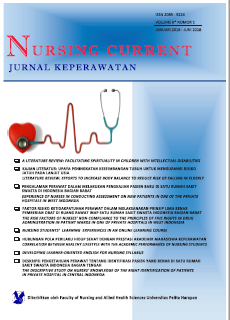NURSING STUDENTS’ LEARNING EXPERIENCES IN AN ONLINE LEARNING COURSE
DOI:
https://doi.org/10.19166/nc.v6i1.1285Kata Kunci:
Nursing Students’ Experience, Online (Blended) LearningAbstrak
To improve the quality of online learning in Indonesia higher education, Faculty of Nursing (FoN), Universitas Pelita Harapan (UPH) supported by the Directorate of Higher Education in Indonesia that known as DIKTI developed an online course named Family Nursing. The course is a community nursing course in regard with the care of family nursing and it discusses the concept of family, family health, and the concept of a wellness family. The course was developed to achieve the mission of equitable access to information, relevance, and improvement of the quality of higher education throughout Indonesia, especially in nursing education. The online course was offered in one private nursing school in Jakarta area that never had any online course nor using online learning method in the delivery of their subjects. The aim of this report was to describe students’ experiences in an online course. This paper reports on the evaluation work of one semester online/blended learning project funded by DIKTI. Sixty five students, who experienced the online/blended learning method for the first time, were enrolled in the online course. The students have agreed to fill an evaluation online form after their mid semester exam. The evaluation form consisted of closed- and openended questions. This report revealed that most students (> 70%) agreed that their experience on the online (blended) learning was positive. However, it should be noted that, a quarter of students (27-28%) had less motivation to do the independent learning and perceived that the online learning was a learning experience that lack of support in developing their critical thinking. Several important themes further emerged including students’ issues (lack of knowledge and motivation), teaching-learning process issues (lack of facilities and clarity) and academic staff issues (minimal feedback and different perceptions between academic staff and students). Though online/blended learning can be employed to support nursing and healthcare education, there is limited appreciation of students' experience and the use of e-learning. Context is also being considered as an important part when applying the online/blended learning, thus, this report provides a new understanding of students’ opinions on their first experience when engaging with online learning at a private nursing school. This report further provides a number of inhibiting factors continue to affect the student experience.
Referensi
Kenny, A. (2002). Online learning: Enhancing nurse education? Journal Advanced Nursing (JAN), 38(2), 127-135. https://doi.org/10.1046/j.1365-2648.2002.02156.x
Dalhem, W. & Saleh, N. (2014). The impact of eLearning on nurses’ professional knowledge and practice in HMC. Canadian Journal of Nursing (CJNI), 9(3). http://cjni.net/journal/?p=3819
McCutcheon, Lohan, Traynor & Martin.(2015). The evidence for ”˜flipping out’: A systematic review of the flipped classroom in nursing education. Nursing Education Today, 38, 15-21 https://doi.org/10.1016/j.nedt.2015.12.010
Betihavas, V., Bridgman, H., Kornhaber, R., & Cross, M. (2016). The evidence for ”˜flipping out’: A systematic review of the flipped classroom in nursing education. Nursing Education Today. 38. Pp. 15-21. https://doi.org/10.1016/j.nedt.2015.12.010
McGowan, B.S., Balmer, J.T., Chappell, K., Dickerson, P.S., Lubejko, B.G. (2014). Flipping the classroom: a data driven model for nursing education. Journal of Continuing Education in Nursing, 45(11),477-478. https://doi.org/10.3928/00220124-20141027-11
McLaughlin, J.E., Roth, M.T., Glatt, D.M., Gharkholonarehe, N., Davidson, C.A., Griffin, L.M., Mumper, R.J. (2013). The flipped classroom: a course redesign to foster learning and engagement in a health professions school. Academic Medicine, 89(2), 236-243. https://doi.org/10.1097/ACM.0000000000000086
Kala, S., Isaramalai S., & Pohthong A. (2010). Electronic learning and constructivism: A model for nursing education. Nurse Education Today, 30(1), 61-66. https://doi.org/10.1016/j.nedt.2009.06.002
Posey L. & Pintz, C. (2017). Transitioning a Bachelor of Science in nursing program to blended learning: Success, challenges & outcomes. Nurse Education in Practice, 26, 26-133. https://doi.org/10.1016/j.nepr.2016.10.006
Hsu, L.L (2012). Qualitative assessment of a blended learning intervention in an undergraduate course. Journal Nursing Research, 20(4), 291-298. https://doi.org/10.1097/jnr.0b013e31827363bc
Mehrdad, N., Zlfaghari, M., ahrani, N & Eybpoosh, S. (2010). Learning outcomes in two different teaching approaches in nursing education in Iran: E-Learning versus lecture. Acta medica Iranica, 49 (5), 297-301. https://scholar.google.com/citations?user=6IRvYQgAAAAJ&hl=en
Smith, G. G., Passmore, D & Faught, T. (2009). The challenges of online nursing education. The Internet and Higher Education, 12 (2), 98-103. https://doi.org/10.1016/j.iheduc.2009.06.007

Unduhan
Diterbitkan
Cara Mengutip
Terbitan
Bagian
Lisensi
Authors who publish with this journal agree to the following terms:
1) Authors retain copyright and grant the journal right of first publication with the work simultaneously licensed under a Creative Commons Attribution License (CC-BY-SA 4.0) that allows others to share the work with an acknowledgement of the work's authorship and initial publication in this journal.
2) Authors are able to enter into separate, additional contractual arrangements for the non-exclusive distribution of the journal's published version of the work (e.g., post it to an institutional repository or publish it in a book), with an acknowledgement of its initial publication in this journal.
3) Authors are permitted and encouraged to post their work online (e.g., in institutional repositories or on their website). The final published PDF should be used and bibliographic details that credit the publication in this journal should be included.

This work is licensed under a Creative Commons Attribution-ShareAlike 4.0 International License.





